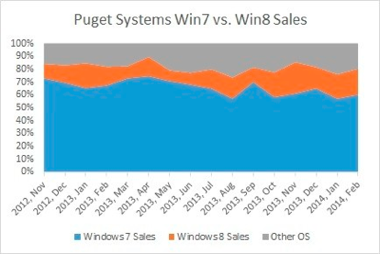Puget has an interesting blog post today sharing some of its experience on how customers have reacted to Windows 8, the operating system's weak adoption, and what they're doing to ease the transition. As a custom system builder, the company argues that Windows 8 may not be their "fault" but it is directly tied to customer experience and thus it has to do something about it.
The new start screen (a.k.a. Metro) is a jolting departure from the user interface that Windows users have been accustomed to using since 1995. According to the company's founder and president, Jon Bach, the general progression of emotions they typically see from new Windows 8 users goes from confusion to frustration, to anger, defeat and acceptance.
Bach points to a recent Reddit thread in which a Microsoft designer candidly explains the decision to make Metro the default. In short, they wanted to go after casual users and mobile devices, and if they didn't shove Metro in people's faces, they wouldn't care to explore and adopt it themselves.

Bach argues that Windows 8 really is a nice operating system once you get past all the terrible user interface decisions that Microsoft has made. There are some worthy technology improvements built in, hardware manufacturers can get more mileage and features out of their hardware with the latest version of Windows, and customers get the longest support life from Microsoft.
With that reality in hand the company has started offering pre-configured systems that run Windows 8 but look and behave more like Windows 7. The program is called "Windows 8 Makeover: Emulate Windows 7" and essentially comprises a few third-party utilities and out-of-the-box tweaked settings.
The courtesy (as in free) software installation includes Classic Shell as a Start menu replacement, making boot to desktop the default setting, replacing Windows 8 apps as the default program where possible for their desktop counterparts, and ditching the charms bar altogether.
Needless to say, by no means are these modifications exclusive to Puget systems. But it goes to show how desktop users – even novices who won't figure these settings on their own – are reluctant to adopt Metro.